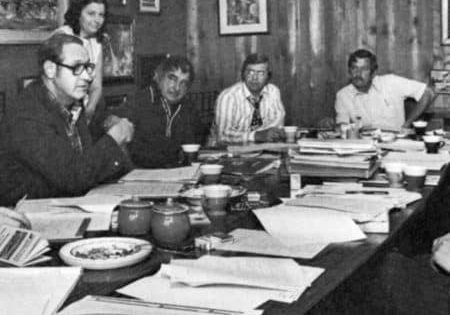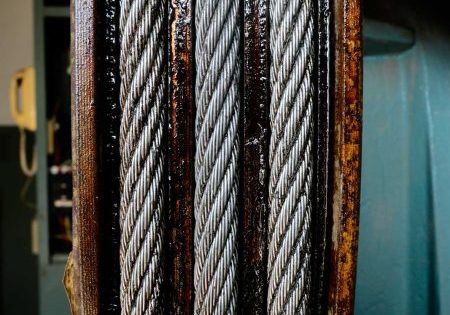Preserving the Past, Elevating the Future
May 5, 2023

One man’s labor of love has grown into a full-fledged museum dedicated to the industry’s history.
For Steve Comley, The Elevator Museum Inc. is a way of giving back to the vertical-transportation industry — a way to make up for actions he was asked to undertake when he was younger. Actions that were necessary, but ones he regretted even then.
One of Comley’s first jobs was working for his father’s elevator company: Embree and White Inc. Millwrights/Elevators, established in 1873. At age 14, he would help his father clean up the shop on the weekends. The big bays would be full of old elevator drum machines and parts. “These machines were some of the most fascinating pieces of heavy-duty equipment I’ve ever seen. My job, unfortunately, was to get rid of them,” Comley said. He would use a sledgehammer to smash them into pieces small enough to load onto a truck and take to the scrap yards.
Comley said:
“I remember asking my father why we had to destroy all these cool old machines that so few people had ever seen before and that would never be seen again. He explained they were removed because the old drum machines were too heavy to keep around, were no longer legal to install and would never run again. I literally felt bad about what I did. I knew the way in which they were casted was a lost art, and they were all made in the U.S. I personally destroyed many antique elevator machines, and now, I have to save some.”
With the Elevator Museum becoming a nonprofit 501(c)(3) organization in 2019 and finding a permanent home in 2022, Comley, its founder and president, is doing just that.
After beginning his career with his father’s company, Comley worked in the elevator industry for more than 43 years and held four licenses: Qualified Elevator Inspector (QEI); New Hampshire State Elevator Inspector; Massachusetts and New Hampshire elevator mechanic; and International Union of Elevator Constructors (IUEC) Boston Local 4 member. He said he worked on some of the oldest pieces of equipment in New England during his tenure and collected “every old elevator artifact I could throughout my career in hopes of building a museum someday.” He added:
“I worked in the elevator industry because it’s a fantastic job that required mechanical and electrical skills, neat old elevator shafts and interesting equipment. As a mechanic, I was paid well, and always working on different types of elevators and locations.”
Elevator Museum History
Patrick Carr ran the Elevator Historical Society and Elevator Museum in NY from 2011 to 2016. It was originally located in the office/parts space of Carr’s elevator consulting firm. Comley was a director of the Elevator Historical Society from 2013 to 2016, but the museum was never open to the public. Due to lack of support and funding, the museum had to close in 2016. Comley asked for the return of his artifacts, as well as those that belonged to his father, and Carr agreed.
I personally destroyed many antique elevator machines, and now, I have to save some.
– Steve Comley, founder and president of The Elevator Museum
During the summer of 2017, Comley made several trips back and forth to NY and brought many artifacts back to the meeting room of Boston IUEC Local 4. He purchased display cases and showcased the items there. Throughout the next two years, many more items were acquired from IUEC members from around the country, Boston Local 4 members and Carr.
In 2018, Comley was asked to remove the artifacts from the meeting room because the display was getting too big. That summer, he started the Elevator Historical Society Committee, through which he added board members and hired the Foundation Group, an organization that specializes in building nonprofits. He established The Elevator Museum Inc. as a nonprofit in 2019. The artifacts were housed in a building in Haverhill, Massachusetts, in 2019 before moving to the museum’s current location at 77 Elm Street in Amesbury, Massachusetts.
The Elevator Museum Today
The Elevator Museum is now housed in a 2,400-ft2, beautifully renovated mill building, complete with a working brewery on the first floor, and there are more than 4,000 elevator artifacts artfully displayed.
Some of the museum’s key, one-of-a-kind artifacts include the 1908 ABSEE elevator machine from Mary Baker Eddy’s mansion, the Otis flyball governor from the Mount Washington Hotel and the original certificates from the White House from 1953, 1954. The museum also features several hand-operated elevators, many of the original ink-on-linen Otis Brothers drawings and the original 1870s Otis Brothers Order Books.
The artifacts come from all over the country and the world, and the museum continues to grow as Comley says he receives new artifacts from “elevator guys and gals” all the time. He recently received a call from someone with IUEC Local 1 in NY, who said they want to donate the old wooden escalator steps from the famous Macy’s Herald Square Department Store.
The people who visit are fascinated with the presentation we have, so I know we are headed in the right direction.
– Steve Comley, founder and president of The Elevator Museum
In its new location, the museum now gets regular visitors and positive feedback. Because of this, Comley says he knows he is doing the right thing by preserving the past. He added:
“I was an elevator mechanic and inspector my entire career but also a self-taught curator and tour guide. I love to walk people around and explain how important the elevator industry was to the development of this great country. People leave with a history lesson about the origins and purposes of the early elevators and how far we have come. The people who visit are fascinated with the presentation we have, so I know we are headed in the right direction.”
Moving forward, his goal is to expand the museum even more. He added:
“I want it to have many more different elevator machines, birdcage cabs and a horizontal piston, to name a few. A lot of the things I want for the museum are still out there, but getting them from there to here has always been the problem.”
Comley retired at the end of March with plans to work part time at the museum, expanding the number of days open from three to four. This will also allow him to pursue grant money for the museum. He said he hopes to soon have a full schedule of events planned. Truth be told, his ideas for the museum seem endless.
“The Elevator Museum has taken many years to get to where we are now, and we can’t look back,” Comley said. “It’s imperative that we preserve these incredibly rare artifacts as a collection for all to see. The Elevator Museum is preserving our past and elevating our future!”
Get more of Elevator World. Sign up for our free e-newsletter.


















